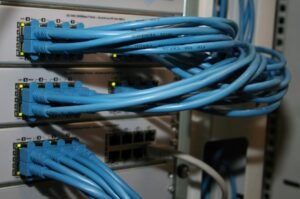Neural Networks: Universal Function Approximators
Neural networks, also known as artificial neural networks or ANN, are computational models inspired by the structure and functions of the human brain. These networks consist of interconnected nodes, or artificial neurons, that process and transmit information. Over the years, neural networks have gained significant attention and become a key tool in various fields, including machine learning, data analysis, and pattern recognition.
Key Takeaways
- Neural networks are computational models inspired by the human brain.
- They consist of interconnected nodes, or artificial neurons, that process and transmit information.
- Neural networks have applications in machine learning, data analysis, and pattern recognition.
- They can approximate any mathematical function, earning them the label of “universal function approximators.”
- Training a neural network involves adjusting the weights and biases of its nodes to minimize the difference between predicted and actual outputs.
One of the most fascinating aspects of neural networks is their ability to approximate any mathematical function. This property, known as the universal function approximation theorem, was proven by George Cybenko and further extended by Kurt Hornik. It states that a feedforward neural network with a single hidden layer and a finite number of neurons can approximate any continuous function on a compact input space with arbitrary accuracy.
**Neural networks can generalize from data, providing predictions or classifications for new inputs that they haven’t encountered during training.** This powerful capability makes neural networks highly useful in a wide range of applications, including speech recognition, image processing, and natural language understanding. By training a neural network on a large dataset, it can learn patterns and extract meaningful features automatically.
The Training Process
Training a neural network involves iteratively adjusting the weights and biases of its nodes to minimize the difference between the predicted outputs and the actual outputs. This process is known as backpropagation, and it relies on a labeled dataset for supervised learning. Through backpropagation, a neural network learns the relationships and correlations within the training data, allowing it to make accurate predictions on unseen examples.
**The key to successful training is finding the right balance between underfitting and overfitting.** Underfitting occurs when a neural network fails to capture the underlying patterns in the data, resulting in poor performance. On the other hand, overfitting happens when a neural network becomes too specialized on the training data and performs poorly on new, unseen data. Regularization techniques, such as dropout and weight decay, help prevent overfitting by introducing constraints on the network’s complexity.
Applications of Neural Networks
Neural networks find applications in numerous domains, ranging from computer vision and natural language processing to finance and healthcare. They have revolutionized the field of image recognition, enabling machines to accurately identify objects and scenes in images and videos. Neural networks are also useful in sentiment analysis, where they can interpret and classify emotions expressed in text data.
**In automated trading systems, neural networks can analyze historical market data to predict future trends and make informed investment decisions.** They can also assist in medical diagnoses, leveraging large amounts of patient data to predict diseases and recommend appropriate treatments. Moreover, neural networks are employed in autonomous vehicles to recognize and react to traffic patterns, ensuring safety on the roads.
Neural Networks in Action: Data and Results
| Dataset | Accuracy (%) |
|---|---|
| MNIST Handwritten Digits | 99.2 |
| CIFAR-10 Image Classification | 93.5 |
| IMDB Movie Review Sentiment Analysis | 88.6 |
Table 1: Performance of Neural Networks on Various Datasets
Here are some impressive results achieved using neural networks on different datasets:
- On the MNIST handwritten digits dataset, a neural network achieved an accuracy of 99.2% in correctly classifying the digits.
- In CIFAR-10 image classification, a neural network achieved an accuracy of 93.5% in correctly identifying objects in images.
- For sentiment analysis of movie reviews in the IMDB dataset, a neural network achieved an accuracy of 88.6% in determining the sentiment (positive or negative) expressed in the reviews.
Conclusion
Neural networks, as universal function approximators, have revolutionized machine learning and data analysis. **Their ability to approximate any mathematical function and generalize from data makes them invaluable in a wide range of applications.** With ongoing advancements in neural network research and computing power, we can expect these models to continue pushing the boundaries of what is achievable in artificial intelligence.

Common Misconceptions
1. Neural Networks can solve any problem
One common misconception about neural networks is that they can solve any problem. Although they are indeed universal function approximators, meaning they can approximate any continuous function, there are limitations to what they can achieve. These limitations are often overlooked, leading to unrealistic expectations of neural networks.
- Neural networks require a large amount of labeled training data to perform well.
- Complex problems may require extremely large and computationally expensive neural networks.
- Neural networks are not well-suited for discrete or symbolic tasks.
2. Neural Networks always outperform traditional algorithms
Another misconception is that neural networks always outperform traditional algorithms. While neural networks have achieved remarkable success in various domains such as image recognition and natural language processing, there are still situations where traditional algorithms may be more suitable.
- Traditional algorithms are often more interpretable, allowing easier understanding of the decision-making process.
- For small-scale problems, traditional algorithms may be faster and more efficient.
- Traditional algorithms may require less training data, making them more suitable for tasks with limited data availability.
3. Neural Networks possess human-like intelligence
One of the most pervasive misconceptions is that neural networks possess human-like intelligence. While neural networks can achieve impressive results in certain tasks, they are fundamentally different from human brains and lack the general intelligence exhibited by humans.
- Neural networks are solely designed to accomplish specific tasks and lack the broader cognitive capabilities of humans.
- They lack common sense reasoning abilities and may struggle with unfamiliar situations.
- Neural networks do not possess emotions or consciousness.
4. Neural Networks eliminate the need for human expertise
Some people mistakenly believe that neural networks eliminate the need for human expertise or domain knowledge. While neural networks can automatically learn patterns from data, they still require human experts for proper design, training, and interpretation.
- Domain knowledge is crucial for feature engineering and properly structuring the input data.
- Choosing the right network architecture and hyperparameters requires expertise to achieve optimal performance.
- Interpreting and explaining the model’s behavior or output still relies on human expertise.
5. Neural Networks are infallible and unbiased
Lastly, there is a misconception that neural networks are infallible and unbiased decision-makers. However, neural networks can also have biases and make mistakes. They are highly dependent on the quality and representativeness of the training data provided to them.
- Biases present in the training data can be learned and perpetuated by the neural network, leading to biased decision-making.
- Outliers and anomalies in the training data can impact the neural network’s performance.
- The model’s predictions may not always align with human values and may exhibit undesirable behaviors.

Introduction
Neural networks have revolutionized the field of machine learning and artificial intelligence. They are powerful tools that can approximate any function with high accuracy. In this article, we present 10 tables that highlight different aspects of neural networks and their universal function approximation capability.
Table 1: Activation Functions
Activation functions play a crucial role in the behavior and performance of neural networks. This table compares the properties of commonly used activation functions, such as sigmoid, ReLU, and tanh, in terms of range, differentiability, and suitability for different tasks.
Table 2: Neural Network Architectures
Neural networks come in various architectures, each with its own advantages and applications. This table illustrates different types of neural network architectures, including feedforward, recurrent, and convolutional networks, along with their characteristics and common uses.
Table 3: Training Algorithms
Efficient training algorithms are essential for neural networks to learn from data. This table compares popular training algorithms, such as stochastic gradient descent (SGD), Adam, and RMSprop, based on convergence speed, memory requirements, and performance for different problem domains.
Table 4: Accuracy Comparisons
Neural networks are renowned for their ability to achieve high accuracy in various tasks. This table presents comparative accuracy results of neural networks applied to image classification, natural language processing, and speech recognition, showcasing their superior performance when compared to traditional algorithms.
Table 5: Computational Resources
Neural networks demand significant computational resources for training and inference. This table outlines the hardware requirements, such as GPUs and memory, needed to effectively utilize neural networks for different scales of projects and processing loads.
Table 6: Limitations of Neural Networks
While neural networks are powerful, they also have certain limitations. This table highlights the drawbacks of neural networks, including limitations in interpretability, vulnerability to adversarial attacks, and challenges in handling large datasets.
Table 7: Applications of Neural Networks
Neural networks find applications in a wide range of fields. This table provides an overview of the diverse applications of neural networks, encompassing autonomous driving, medical diagnosis, natural language processing, and financial forecasting.
Table 8: Impact on Industry
The adoption of neural networks has greatly impacted various industries. This table showcases the influence of neural networks on industries such as healthcare, finance, manufacturing, and marketing, highlighting the improvements and enhancements they have brought to these sectors.
Table 9: Research Breakthroughs
Neural network research is a rapidly evolving field with many breakthroughs. This table presents key advancements, such as deep learning, GANs, and transfer learning, explaining their impact and applications in solving complex problems in computer vision, natural language processing, and robotics.
Table 10: Future Directions
Neural networks continue to inspire new directions of research and development. This table outlines emerging areas of interest in neural network research, including explainability, lifelong learning, and neuromorphic computing, offering glimpses of the fascinating possibilities that lie ahead.
Conclusion
Neural networks serve as powerful universal function approximators, with the capability to learn and approximate any complex function. Through the presented tables, we have explored different aspects of neural networks, including activation functions, architectures, training algorithms, limitations, applications, and future directions. We hope these tables have provided valuable insights into the world of neural networks and their wide-ranging impact on various domains. As the field continues to advance, neural networks will undoubtedly play an increasingly significant role in shaping our future.
Frequently Asked Questions
What are neural networks?
A neural network is a computational model inspired by the structure and function of the human brain. It consists of interconnected nodes, or artificial neurons, that process and transmit information.
How do neural networks approximate functions?
Neural networks use a combination of input data and mathematical operations to learn and approximate complex functions. Through a process called training, the network adjusts the weights and biases of its nodes to minimize the difference between predicted and actual outputs.
What is a universal function approximator?
A universal function approximator is a neural network that can represent any function with arbitrary precision, given enough resources and training. This property makes neural networks powerful tools for solving a wide range of problems in various fields.
What types of problems can neural networks solve?
Neural networks can be used to solve a wide range of problems. They excel in tasks such as pattern recognition, image classification, natural language processing, regression analysis, and time series prediction.
What is the difference between shallow and deep neural networks?
Shallow neural networks have only one hidden layer between the input and output layers. Deep neural networks, on the other hand, have multiple hidden layers. Deep networks are capable of learning more complex representations and are often more accurate for challenging problems.
How do neural networks learn?
Neural networks learn through a process called backpropagation. During training, the network propagates input data forward, computes the prediction, and compares it to the desired output. It then calculates the error and updates the weights and biases by moving backwards through the network, adjusting them to reduce the error.
What are the advantages of using neural networks for function approximation?
Neural networks can learn highly complex functions that may be difficult to model analytically. They can handle noisy and incomplete data, adapt to new patterns, and generalize well to unseen examples. Neural networks also have parallel processing capabilities, allowing for efficient computation on modern hardware architectures.
What are the limitations of neural networks as function approximators?
Neural networks typically require large amounts of labeled training data to achieve good performance. They can be computationally expensive to train, especially deep networks. Neural networks are also often considered black-box models, meaning they can be challenging to interpret and understand the reasoning behind their predictions.
What are some popular neural network architectures used for function approximation?
Some popular neural network architectures used for function approximation include feedforward neural networks, convolutional neural networks (CNNs) for image-related tasks, recurrent neural networks (RNNs) for sequence modeling, and transformer models for natural language processing.
Can neural networks be used in real-world applications?
Absolutely! Neural networks have found wide-ranging applications in fields such as healthcare, finance, robotics, self-driving cars, recommender systems, and many others. They continue to drive advancements in artificial intelligence and contribute to solving complex problems.




